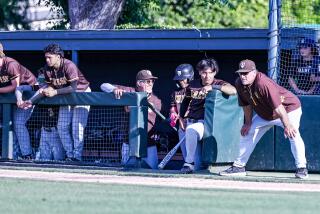Some Dreams Over When Mission Teams Go Under
- Share via
For summer jobs, Julio Archila and Jose Ballesteros are toiling in the bowels of the Anheuser Busch plant in North Hills, tending to a battery of immense beer tanks.
“We stuff them with beechwood chips,” Archila said. “The solutions and acids you use for cleaning [the tanks] are kind of messy and you get a lot of different aromas. You smell things you’ve never smelled in your life.”
But the tanks aren’t the only things in Archila and Ballesteros’ lives that stink these days. They, along with about 30 other young men, have lost the opportunity to play soccer at Mission College, which eliminated its athletic program earlier this month because of a lack of funding.
“Soccer is my passion,” Archila said. “I still haven’t accepted that we don’t have a team.”
Predictably, the demise of a junior college soccer team loaded with Latino players drew little protest. Valley residents get more upset when their favorite doughnut shop goes under.
Here’s a reason to lament the program’s passing: it drew kids with few options into college classrooms and provided them with a path out of their lower-class surroundings and dead-end jobs.
“Ninety-five percent of my kids are in school because of soccer,” Mission Coach Adolfo Perez said. “They need to go to college. It’s their only way out.”
Though his pulpit has been pulled from beneath him and his flock has scattered, Perez knows of what he preaches. The son of a mother with a first-grade education and a father with none, Perez went from Birmingham High to Cal State Northridge on a soccer scholarship and graduated in 1994.
“Some people think [junior colleges] are not real school, but for a lot of people it’s college and it’s a step in the right direction,” Perez said. “If these kids didn’t play, they were working and whatever they made was more than they had ever had in their lives. I told them if you go to school you can get a better job and make more.”
In Perez’s two seasons at Mission, the Free Spirit was 21-10-8. It earned a state playoff berth in 1995 and narrowly missed another last season. Mission was 0-16 the season before Perez arrived.
Perez recruited tirelessly and once he landed players, he helped them fill out financial aid papers, form carpools and find classes. He came up with used textbooks to be shared by players who couldn’t afford them. He dragged team members from their beds to attend class.
“Coaching was 10% of the job,” Perez said. “I was the father, the counselor, the coach. Helping those kids made my day. When they were happy, I was happy.”
This is not to say that Perez presided over soccer utopia. Tension existed between Latino and white players. Players who sought out the team resented those who had been pursued by Perez.
Many players dropped out of school, but the program’s good could not be discounted.
“I felt good if one or two out of 10 guys from schools like Poly or Sylmar or San Fernando [Highs] stayed at Mission,” Perez said. “It’s easy for someone who’s educated to say that’s no good but one or two is more than zero.”
John Klitsner, who until this month served as Mission’s athletic director, echoed Perez’s sentiments.
“Some of [the players] were getting an education almost in spite of themselves,” Klitsner said. “If only a couple of them became solid citizens, that’s still a good job.”
Forward Diego Aguirre and defender Tim Abernathy testify to the program’s impact on their lives.
Aguirre, 24, is a Colombian who briefly attended North Hollywood High and has excelled in industrial engineering even while playing soccer and working two jobs.
“I know from my friends, this program helped them get out of the streets,” Aguirre said.
“They got to know another kind of life, not gangs and everything. One of them told me he’d never liked to study before, but once he had to study to play, he likes it now.”
Abernathy, a 23-year-old El Camino High graduate and a former Marine, discovered an unknown talent for writing at Mission, although English had been his worst subject.
“I came back to the school scene and it just turned me around,” Abernathy said. “I don’t buy into the idea that [Mission offers] a lesser education because it’s a [junior college].”
Perez lined up 22 new players for the 1997 season and would have combined them with at least half a dozen returnees. Mission was expected to challenge for the conference title.
There will be none of that now. The parched, uneven field the team played on will be used only by recreational teams, not by players trying to pull themselves up by their shinguard straps.
Few of the players have any concrete plans. When you catch them over the phone between jobs, they do their best to sound optimistic. Mostly they fail.
The nearest junior college programs are at Glendale and Moorpark, yet both are strong programs with large turnouts of their own. Many of the former Mission players don’t have cars. They will go back to playing soccer in the parks.
“I was thinking the program, it could help me get a scholarship for UCLA or another university,” Aguirre said. “But now I don’t know what I’m going to do. That was my opportunity.”
More to Read
Get our high school sports newsletter
Prep Rally is devoted to the SoCal high school sports experience, bringing you scores, stories and a behind-the-scenes look at what makes prep sports so popular.
You may occasionally receive promotional content from the Los Angeles Times.






